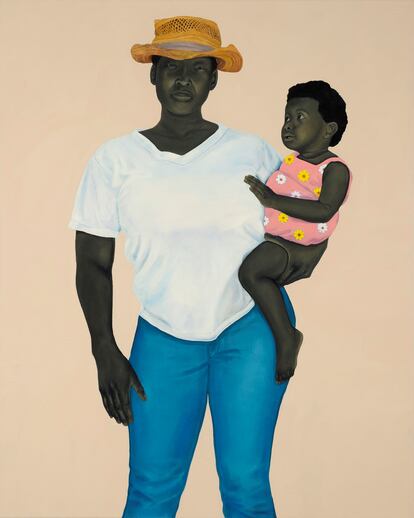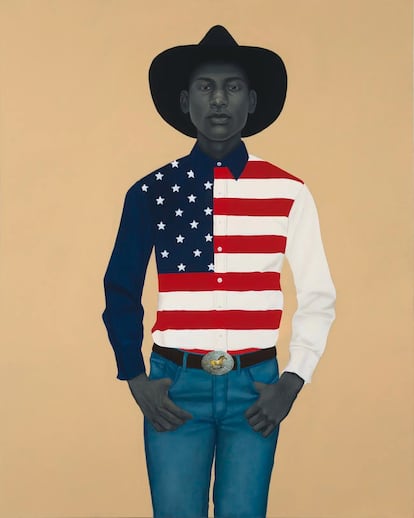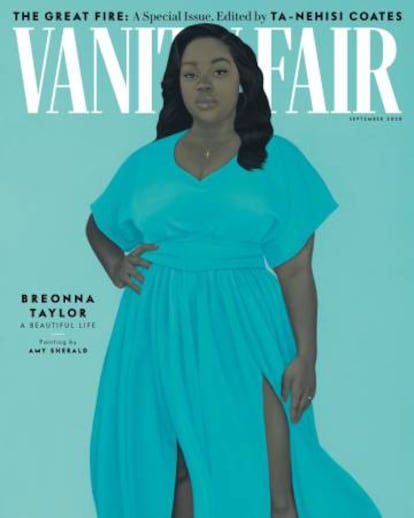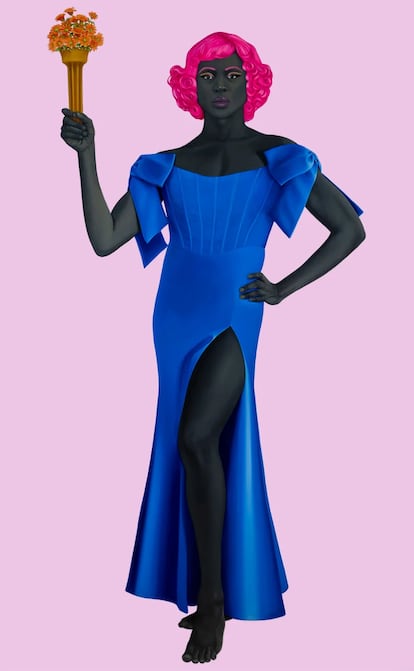American Sublime, Of the African -American portraitist Amy Sherald, it has been one of the exhibitions of the year as it passes through the Modern Art Museums of San Francisco and Whitney, in New York, where it will close in August. Until Thursday, it was also planned to be the sensation of the new season in Washington, as part of the National Portrait Gallery program. Sherald, who conquered fame beyond art after painting Michelle Obama, wife of former president Barack Obama, suspended the exhibition after denouncing “censorship.”
His decision not to fulfill what was agreed with Smithsonian, a network of 21 free centers that depend on the federal government, is due to the suggestion, according to the artist, made by the managers of the National Portrait Museum, which tells the history of the United States through their characters, to withdraw from the last stop of the tour of the tour of American Sublime The picture Trans Forming Liberty (2024), which represents a non -binary trans person who poses in the manner of the statue of freedom.
According to Sherald, the Smithsonian invited him to get the work out of the tour so as not to anger Donald Trump, who has the institution in the spot and has embarked the government into a campaign against trans people since his return to the White House.
“I do not blame anyone specifically,” Sherald writes in the statement with which his cancellation made public. It is evident that there is fear in the institutions, and that it is conditioned by a broader climate of political hostility towards trans lives. “The artist also says that” in conscience “does not” abide “that” culture of censorship, especially when it is directed against vulnerable communities. “
The National Portrait Gallery was, ironically, the scene of her consecration. There he presented in 2018 the picture of Michelle Obama with the one who made her husband the artist Kehinde Wiley, another essential name in the renewal of the language of contemporary African -American portrait. That free show was visited by four million people. Then, he undertook a successful tour of the country. Both paintings were a museum, which has among its parcels hang paintings or photographs of all the presidents and, from a more recent time, also of the first ladies.
According to Sherald, he was the secretary of the Smithsonian, the African -American historian of Lonnie G. Bunch III, who suggested replacing the portrait of discord with a video about the visitors’ reactions to the painting. The artist then decided to cancel the exhibition.
On Wednesday he sent a letter to Bunch, according to The New York Times, The medium that advanced the news, in which I said: “I accepted this collaboration in good faith, convinced that the institution shared the commitment to present works that reflected the full and complex reality of American life. Unfortunately, it has become clear that conditions no longer allow the integrity of the proposal as conceived.”

The Smithsonian replied with a statement that highlights the common history of the institution with Sherald. “While we understand Amy’s decision to withdraw his exhibition, he disappoints that Smithsonian’s public does not have the opportunity to experiment American Sublime”, The text says. “By presenting and contextualizing art, Smithsonian seeks to inspire, challenge and impact the public in significant and reflective ways. Unfortunately, we could not reach an agreement with the artist.”
Trump’s decree
Last March, Trump signed a decree with which he intervened in fact in the Smithsonian museums and in the Washington Zoo, also of Federal Management. The executive decision was titled Restoring truth and sanity in the history of the United States, and in it he ordered that a cleaning of “inappropriate, divisive or anti -American” ideology be undertaken in these institutions. He also commissioned that task to the vice president, JD Vance.
As with many of his decisions, the scope of that order is not clear, beyond the dismissal or resignation of some conservatives (including Kim Sajet, director of the NPG, to which Trump pointed out), the elimination of the programs of inclusion of museums and, as has been demonstrated with Sherald, the propagation of fear between the institutions and of a certain mechanism of prior censorship.
The White House told the Times that “the elimination of the sample is a necessary measure and principles” to restore the function that the Smithsonian assumes. The author of that statement seemed to ignore that no one eliminated the exhibition, and it was the artist herself who did not want to pass through the ring of the new conditions of the museum.
The model of Trans Forming Liberty It’s called Arewà Basit. She is an artist, actress, singer and non -binary trans singer. In the audioguía of the exhibition, which can be consulted on the Whitney website, Basit explains: “When I see the painting, I remember all those years in which they forced me (in school) to recite the oath to the flag. It was when seeing this version of the statue of freedom when I discovered the true meaning of those words. It is really an empowered woman, who empowers and that represents the fullness of what freedom and justice have to offer. They can mean. ”

The exhibition American Sublime He proposes a tour of Sherald’s work, 51. It is famous for its portraits full of dignity of African -American models, which it paints with expressive color fields, with a mixture of optimism and restlessness and using a gray scale that serves to reflect on identity traps. The result is an inquiry in the place of black people in American society before and after the murder of George Floyd that unleashed the anti -racist protests of the Black Lives Matter movement, conquests that Trump’s new administration tries to reverse.
One of the icons of that wave of protests was, precisely, a portrait that Sherald made of Breonna Taylor, a nurse to which some police officers killed in her home in Louisville (Kentucky). That death contributed to light the spark of the protests. The magazine Vanity Fair He made a notable exception by putting the picture on the cover of his September issue of that year. The original painting is included in the sample that can no longer be seen in Washington.


